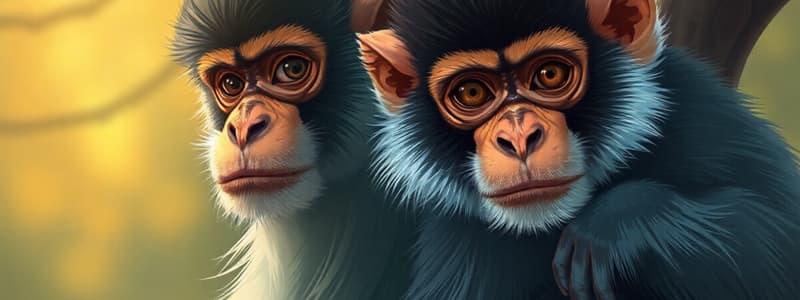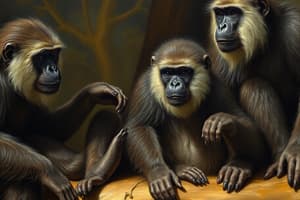Podcast
Questions and Answers
What is the dental formula for New World Monkeys (NWM)?
What is the dental formula for New World Monkeys (NWM)?
2.1.3.3
New World Monkeys have _____ molars adapted for eating leaves.
New World Monkeys have _____ molars adapted for eating leaves.
bilophodont
A characteristic trait of many New World Monkeys is a _____ tail, which can grasp objects.
A characteristic trait of many New World Monkeys is a _____ tail, which can grasp objects.
prehensile
New World Monkeys exhibit a _____ nose, characterized by wide-set, outward-facing nostrils.
New World Monkeys exhibit a _____ nose, characterized by wide-set, outward-facing nostrils.
What is the typical mode of locomotion for New World Monkeys?
What is the typical mode of locomotion for New World Monkeys?
What is the dental formula for Old World Monkeys (OWM)?
What is the dental formula for Old World Monkeys (OWM)?
Old World Monkeys possess slanted _____ premolars.
Old World Monkeys possess slanted _____ premolars.
True or False: Like New World Monkeys, Old World Monkeys have bilophodont molars adapted for eating leaves.
True or False: Like New World Monkeys, Old World Monkeys have bilophodont molars adapted for eating leaves.
The nose type characteristic of Old World Monkeys is _____, with narrow, downward-facing nostrils.
The nose type characteristic of Old World Monkeys is _____, with narrow, downward-facing nostrils.
True or False: Old World Monkeys typically have prehensile tails.
True or False: Old World Monkeys typically have prehensile tails.
What is the dominant form of locomotion for Old World Monkeys?
What is the dominant form of locomotion for Old World Monkeys?
Apes are characterized by having _____ fingers, which aid in grasping and brachiation.
Apes are characterized by having _____ fingers, which aid in grasping and brachiation.
Compared to Old World Monkeys, apes have a _____ lumbar region.
Compared to Old World Monkeys, apes have a _____ lumbar region.
What is the dental formula shared by Apes and Old World Monkeys?
What is the dental formula shared by Apes and Old World Monkeys?
Apes have _____ molars adapted for eating fruit.
Apes have _____ molars adapted for eating fruit.
True or False: Apes possess a tail.
True or False: Apes possess a tail.
What specialized form of arboreal locomotion, involving arm-swinging, is particularly associated with some apes?
What specialized form of arboreal locomotion, involving arm-swinging, is particularly associated with some apes?
Many prosimians possess a _____ _____ and a _____ _____ for grooming purposes.
Many prosimians possess a _____ _____ and a _____ _____ for grooming purposes.
Instead of fully enclosed eye orbits like monkeys and apes, prosimians have a _____ _____ _____.
Instead of fully enclosed eye orbits like monkeys and apes, prosimians have a _____ _____ _____.
The sharp and triangular cusps on the teeth of many prosimians are adaptations for eating what?
The sharp and triangular cusps on the teeth of many prosimians are adaptations for eating what?
Prosimians often exhibit _____ eye orbits, frequently linked to nocturnal activity.
Prosimians often exhibit _____ eye orbits, frequently linked to nocturnal activity.
What does VCL stand for in the context of prosimian locomotion?
What does VCL stand for in the context of prosimian locomotion?
The presence of a _____ (wet nose) is characteristic of prosimians and indicates a greater reliance on smell.
The presence of a _____ (wet nose) is characteristic of prosimians and indicates a greater reliance on smell.
A general characteristic of primates is having _____ digits on both hands and feet, often with nails instead of claws.
A general characteristic of primates is having _____ digits on both hands and feet, often with nails instead of claws.
What term describes the grasping ability, using hands and feet, that is characteristic of primates?
What term describes the grasping ability, using hands and feet, that is characteristic of primates?
Most primates (monkeys, apes, humans) have fully _____ _____ _____, offering greater protection to the eyes.
Most primates (monkeys, apes, humans) have fully _____ _____ _____, offering greater protection to the eyes.
Compared to many other mammals, primates generally exhibit a _____ snout.
Compared to many other mammals, primates generally exhibit a _____ snout.
Which primate group includes lemurs, lorises, and tarsiers?
Which primate group includes lemurs, lorises, and tarsiers?
Flashcards
NWM dental formula
NWM dental formula
Dental formula for New World Monkeys.
Prehensile tail
Prehensile tail
Possessing a grasping tail used as an extra limb.
Platyrrhine nose
Platyrrhine nose
Nostrils are far apart and face sideways. Common in NWM.
Arboreal
Arboreal
Signup and view all the flashcards
OWM dental formula
OWM dental formula
Signup and view all the flashcards
Catarrhine nose
Catarrhine nose
Signup and view all the flashcards
Terrestrial quadrupedalism
Terrestrial quadrupedalism
Signup and view all the flashcards
Long fingers (Apes)
Long fingers (Apes)
Signup and view all the flashcards
Short lumbar region (Apes)
Short lumbar region (Apes)
Signup and view all the flashcards
Brachiation
Brachiation
Signup and view all the flashcards
Primates
Primates
Signup and view all the flashcards
Prehensility
Prehensility
Signup and view all the flashcards
Enclosed eye orbits
Enclosed eye orbits
Signup and view all the flashcards
Reduced snout
Reduced snout
Signup and view all the flashcards
Prosimians
Prosimians
Signup and view all the flashcards
Tooth comb
Tooth comb
Signup and view all the flashcards
Post orbital bar
Post orbital bar
Signup and view all the flashcards
VCL
VCL
Signup and view all the flashcards
Rhinarium
Rhinarium
Signup and view all the flashcards
Large eye orbits
Large eye orbits
Signup and view all the flashcards
Study Notes
-
NWM refers to New World Monkeys
- Dental formula is 2.1.3.3
- Have bilophodont molars and eat leaves
- Possess a prehensile tail and a platyrrhine nose
- Arboreal locomotion
- Have a small body size
- Have 3 premolars
-
OWM refers to Old World Monkeys
- Dental formula of 2.1.2.3
- Slanted sectorial premolars
- Bilophodont molars for eating leaves
- Long lumbar region
- Catarrhine nose
- Short, non-prehensile tail
- Terrestrial quadruped locomotion
Ape Characteristics
- Long fingers and a short lumbar region
- 2.1.2.3 dental formula with sectorial straight premolar
- Bunodont premolars for eating fruit
- Catarrhini nose
- No tail
- Mode of locomotion is brachiation
Primates
- 5 digits on hands and feet
- Prehensility
- Enclosed eye orbits
- Reduced snout
- Includes lemurs, lorises, and tarsiers
Prosimians
- Possess a tooth comb/grooming claw
- Post orbital bar
- Sharp and triangular cusp for eating insects
- Dental formula is 2.1.3.3
- Large orbital size
- Use VCL (vertical, clinging, leaping)
- Reduced snout
- Rhinarium nose (wet)
- Have 5 digits
- Exhibit prehensility
- Large eye orbits
- Mobile ears
- Large, wet snout
Studying That Suits You
Use AI to generate personalized quizzes and flashcards to suit your learning preferences.



